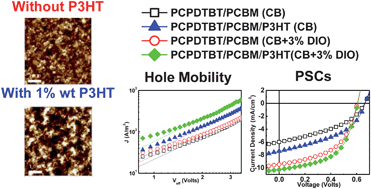Enhancing the efficiency of low bandgap conducting polymer bulk heterojunction solar cells using P3HT as a morphology control agent
Abstract
The development of low bandgap conducting

* Corresponding authors
a Graduate Institute of Applied Physics, National Taiwan University, No. 1, Sec. 4, Roosevelt Road, Taipei 106-17, Taiwan
b
Department of Materials Science and Engineering, National Taiwan University, No. 1, Sec. 4, Roosevelt Road, Taipei 106-17, Taiwan
E-mail:
suwf@ntu.edu.tw
Fax: +886 2 33664078
Tel: +886 2 33664078
c
Department of Physics, National Taiwan University, No. 1, Sec. 4, Roosevelt Road, Taipei 106-17, Taiwan
E-mail:
yfchen@phys.ntu.edu.tw
Tel: +886 2 33665125
d Institute of Polymer Science and Engineering, National Taiwan University, No. 1, Sec. 4, Roosevelt Road, Taipei 106-17, Taiwan
The development of low bandgap conducting

 Please wait while we load your content...
Something went wrong. Try again?
Please wait while we load your content...
Something went wrong. Try again?
S. Chang, H. Liao, Y. Shao, Y. Sung, S. Hsu, C. Ho, W. Su and Y. Chen, J. Mater. Chem. A, 2013, 1, 2447 DOI: 10.1039/C2TA00990K
To request permission to reproduce material from this article, please go to the Copyright Clearance Center request page.
If you are an author contributing to an RSC publication, you do not need to request permission provided correct acknowledgement is given.
If you are the author of this article, you do not need to request permission to reproduce figures and diagrams provided correct acknowledgement is given. If you want to reproduce the whole article in a third-party publication (excluding your thesis/dissertation for which permission is not required) please go to the Copyright Clearance Center request page.
Read more about how to correctly acknowledge RSC content.
 Fetching data from CrossRef.
Fetching data from CrossRef.
This may take some time to load.
Loading related content
